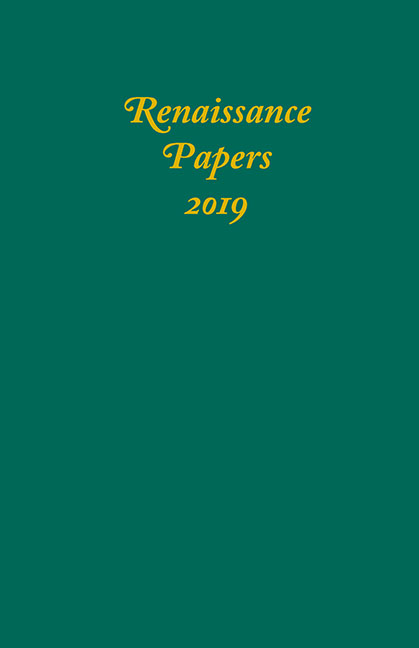Book contents
- Frontmatter
- Contents
- Dedication
- The Names’ Two Bodies: Mary, Queen of Scots, Elizabeth I, and the Politics of Correspondence
- “Of that Wide Gap”: Liminality and the Gap of Time in The Winter’s Tale
- “To kill a Wife with Kindness”: Contextualizing Shakespeare’s The Taming of the Shrew
- The Harvest of Mysticism in English Renaissance Literature: Ascesis in Spenser and Shakespeare— “silencing the tumult of the flesh”
- A House of Spiderwebs: George Herbert and the Estate Poem
- The Judith Narrative in Margaret Tyler’s Mirror of Princely Deeds
- Knowing Owen: Merry and Satirical Epitaphs on a Butler of Christ Church, Oxford
- Margaret Cavendish and Ben Jonson: Ladies’ Spaces, Boy Actors, and Wit
- Parnassus Commodified: Ben Jonson and the Printing of Value
A House of Spiderwebs: George Herbert and the Estate Poem
Published online by Cambridge University Press: 23 October 2020
- Frontmatter
- Contents
- Dedication
- The Names’ Two Bodies: Mary, Queen of Scots, Elizabeth I, and the Politics of Correspondence
- “Of that Wide Gap”: Liminality and the Gap of Time in The Winter’s Tale
- “To kill a Wife with Kindness”: Contextualizing Shakespeare’s The Taming of the Shrew
- The Harvest of Mysticism in English Renaissance Literature: Ascesis in Spenser and Shakespeare— “silencing the tumult of the flesh”
- A House of Spiderwebs: George Herbert and the Estate Poem
- The Judith Narrative in Margaret Tyler’s Mirror of Princely Deeds
- Knowing Owen: Merry and Satirical Epitaphs on a Butler of Christ Church, Oxford
- Margaret Cavendish and Ben Jonson: Ladies’ Spaces, Boy Actors, and Wit
- Parnassus Commodified: Ben Jonson and the Printing of Value
Summary
THE saintly George Herbert, who has a day (February 27) in Lesser Feasts and Fasts of the Episcopal Church, has been under siege for about a generation. Some critics, it would seem, have no use for saints; some, more generally, have no use for the Christian faith; some simply want to correct what seems to them a one-sided notion. All reflect an emphasis on politics in literary judgements.
The effect of this is to nudge Herbert, comfortably regarded for generations as metaphysical friend and follower of John Donne, in the direction of the Cavalier poets, for whom the power struggles of aristocracy and court were never out of sight for long. No poetic form is more typical of these writers than the country house (or estate) poem, “To Penshurst” and “To Sir Robert Wroth” being the prototypes. Herbert's brief ecclesiastical career was spent in close proximity to one of the great country houses of southern England, Wilton House, the seat of the Earls of Pembroke. He was related to the family and was probably in the house with some frequency. It follows, then, that if Herbert is a kind of honorary Cavalier poet, it would be natural to find him celebrating the house and estate in some manner comparable to Jonson’s. After all, Penshurst and Durrants and Wilton were all Sidney houses. If we look carefully, can we find enough puzzle pieces to constitute Herbert's “To Wilton”?
Here, for the sake of clarity, is a list of the leading characteristics of Jonson's two estate poems:
1 Architecture is not a main concern, though it provides the opening- by-negation of “Penshurst” and is present in a single line near the beginning of “Wroth” in the form of “proud porches” and “gilded roofs” (15).
2 The fecundity of both estates is emphasized; their power to provide food in plenty.
3 Both estates are part of the Sidney family history—explicit in “Penshurst,” understood in “Wroth.”
4 The harmonious mingling of classes occurs in both, though evidently as an event to be noted, not necessarily a frequent occurrence.
5 The rural repose of both may be broken in upon by the Court, specifically by the King's love of hunting. Moreover, the court masque casts its shadow onto these estates, explicitly in the case of “Wroth,” and retroactively from there onto “Penshurst.”
- Type
- Chapter
- Information
- Renaissance Papers 2019 , pp. 59 - 72Publisher: Boydell & BrewerPrint publication year: 2020

